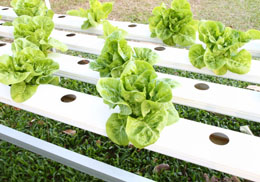Hydroponics is a revolution in gardening and agriculture in general. Homemade systems can be set up quite easily. In this article, I provide a basic know-how of implementing some of the major types.

For people who do not have the means to set up a conventional garden, a homemade hydroponic system offers an effective substitute, as it is soil-less gardening.
A Brief Introduction
Hydroponics is growing plants without soil. This technique is indeed a radical shift from conventional gardening, farming, and allied techniques of growing vegetation, which are all soil-based. This technique involves growing plants in mineral and nutrient-rich solutions, in water. Soil is essentially a nutrient-rich medium, from which plants absorb nutrients, that are dissolved in water. The idea behind this new paradigm-shifting gardening or farming technique is that plant growth is possible, without soil, if the nutrient medium that it provides, is substituted by a water-based solution. Most terrestrial plants have been successfully grown in hydroponic systems.
Advantages
Some of the main advantages of growing plants hydroponically are the following:
- The basic advantage is that you don't have to worry about choice of soil, as it is not required. Its absence eliminates all the soil-related problems.
- One can achieve an economical nutrient supply and save on related costs. One has greater control over the supply of nutrients, than in a soil-based environment.
- Proven high yields are testimony to the advantage it offers over conventional soil-based gardening or farming.
- Excessive nutrient pollution, that often occurs in soil-based systems is avoided.
- Plant-related diseases and pests can be eliminated more easily due to the water-based culture and the inherent mobility that the technique offers.
- Using these systems, one can have vegetation where natural soil does not support it or is not conducive to its growth.
Types
Let us look at the main types of hydroponic systems, that can be set up easily. Here are three of them.
Deep Water Culture
One of the most popular systems is the deep water culture method. All that you need to build it, is a plastic storage bin, airstone, aquarium pump, and nutrient mixture. You fill the (preferably dark-colored) tank with water, add nutrient mixture, and cover it with a lid so that the water surface is not exposed to light. Cut holes in the lid to place plants, in such a fashion, that plants can be placed or grown without the water being exposed to light. Attach the air pump from one side to aerate the water. It is vital that the pH level and nutrient content is maintained for good growth.
Wick Based
The wick system employs two storage bins, instead of one, and uses nylon rope and air pumps for setting up a hydroponic system. One bin is the plant container with airstones and an air pump attached, while the other bin serves as a nutrient reservoir. Placed one above another, let the plant container be at the top. Every plant container should have a nylon rope passing around it, which is left hanging, down into the solution. When each of the plant containers is filled with vermiculite and perlite, wicking of water from the rope to the plant, will be made possible.
Ebb and Flow
In this method, plants and the nutrient solution are separately placed. The plant container tub is periodically flooded by a nutrient solution, using a timer-based pump. When the plant roots have soaked nutrients, the solution is drained back into the nutrient reservoir.
These three are some of the simplest systems to set up. This technology is still in a nascent stage and is finding rapid commercial use, due to the reported increase in yield, reported by hydroponic farms.






 For people who do not have the means to set up a conventional garden, a homemade hydroponic system offers an effective substitute, as it is soil-less gardening.
For people who do not have the means to set up a conventional garden, a homemade hydroponic system offers an effective substitute, as it is soil-less gardening.